Hybrid Work Culture:How managers can build and sustain it
Necessity, they say, is the mother of invention.
And this need for invention has never been more urgent and important than in recent times. What do I mean?
The pandemic upset the balance of the professional world. In the heat of it all, 44% of employees were working fully remotely as opposed to the 17% pre-pandemic per a Statista report.
This upward trend in remote working posed problems for two reasons:
First, a lot of companies’ cultures were deteriorating….fast. A recent study by the Society for Human Resource Management conducted in April 2020 revealed more than one-third of employers and managers were facing challenges maintaining company culture.
Managers had no option than to invent new ways in order to engage employees and maintain their culture.
Secondly, many managers soon realized 100% remote working couldn’t work for all companies. Some employees’ roles couldn’t be performed efficiently by teleworking because of the physical distance. They could only be performed in-office.
What better alternative arose as a result of this necessity?
Hybrid working.
Hybrid working operates like this: Employees with specialized roles can work physically, while other employees work remotely. Or, all employees work both remotely and in-office on certain days.
A hybrid work model allows companies to enjoy the pros that working face-to-face and remotely both offer while alleviating their cons. Literally enjoying the best of both worlds.
And what’s the verdict?
The hybrid model of working is here to stay, and many experts have echoed this sentiment. For instance, Sagi Gidali, CPO and Co-founder of Perimeter 81, who sees “Hybrid models as the future of work.
But for the hybrid model to be truly productive, it has to have a great workplace culture. No two ways about it. Good company culture has been linked with employee engagement, retention, productivity, and more sales.
Lars Hyland, Chief Learning Officer of Totara Learning, said:
The shift to hybrid work demands a rebalanced workplace culture and new supporting technology.
More than ever, it is important for managers to pay attention and revamp their workplace culture. The culture that worked when your company was physical won’t work anymore.
New hybrid work culture strategies are needed:
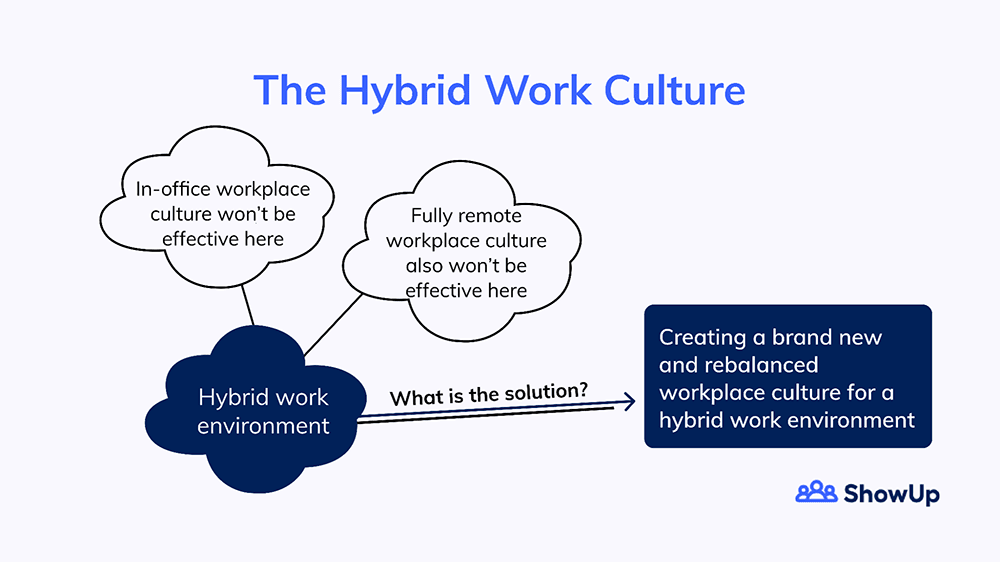
And so, for clicking on this piece to learn more about hybrid work culture, I must commend you for being a forward-thinking manager.
In return, I’ll reveal highly effective ways to build your hybrid work culture in this piece. And also how ShowUp, a team pulse survey tool, can help you, a manager, maintain your company’s culture.
Measure and Maintain Your Hybrid Workplace Culture with ShowUp
Table of Contents:
How to build and sustain a hybrid work culture
Quite a number of leaders and managers worry about sustaining their culture in a hybrid work mode. In fact, a Gartner survey of some company leaders revealed among the challenges of managing a hybrid workforce, 30% of business leaders are most concerned with maintaining the corporate culture.
But these leaders needn’t dwell so much on their previous culture.
This transition to a new way of working means every company now has a clean slate to start over in terms of its culture.
Like Bill Schaninger, Senior Partner, McKinsey, said in this podcast:
This is an unbelievable opportunity to remake culture. It’s rare in a leader’s lifetime to have such a clean drop for reshaping how you run the place.
In the spirit of recreating your hybrid culture, below are 7 ways you can do that.
Be flexible
What has flexibility got to do with building a great hybrid work culture, you ask?
Everything.
The very idea of working hybrid arose from the flexibility of companies’ managers and leaders, and so it continues to thrive on that same flexibility. Being flexible means giving your employees a choice in how they want to navigate the hybrid model.
Twitter, for instance, understood the need for flexibility.
The company gave its employees the opportunity to visit the office as often as they want to or not. Twitter’s employees were encouraged to do what they felt was best for themselves.
Jeff Schwartz, a Founding Partner of Deloitte Consulting’s Future of Work practice and author, also opined on this:
Find out from employees what works for them at this time in their lives
The result of doing this is your employees are happy and content with their working conditions. And, of course, happy and contented employees make up a great work culture.
Take the mental health of employees seriously
It goes without saying, but when your employees are not at their best mentally, your culture will suffer greatly.
How?
Affected employees are likely to be animus towards colleagues, have poor relations with customers, be disengaged, and even leave the company. All of this affects the culture of the hybrid workplace.
Now, where do you come in as the manager?
Support your employees health-wise both physically and mentally. Kelly Greenwood and Natasha Krol, Principal Leaders in Mind Share Partners, wrote in this HBR Piece:
The role of a manager remains the same: to support your team members. That includes supporting their mental health.
You can support them by first and foremost communicating with them. Harvard Business Review reports that employees who say their manager is not good at communicating are 23% more likely to experience mental health declines. Therefore, communicating consistently with your staff is a great way to support their mental health.
But let’s be realistic for a moment.
If you’re managing anything from 10-15+ employees, the reality is you can’t communicate with every one of them one by one. Some are probably now working remotely and others in-office, making it all the more difficult.
Your best bet?
Make it easier for the employees you manage to open up to you.
People take matters related to mental health very seriously. As such, most employees won’t open up to you or others on the team if there’s no politeness in the team conversations.
On your own, you might not be able to detect mental health issues bottled up by your employees. But you can make it easier for them to open up by being polite in your communication.
And that's where using regular, bite-sized surveys to get a pulse of how all your employees feel about the level of politeness in the organization comes in:
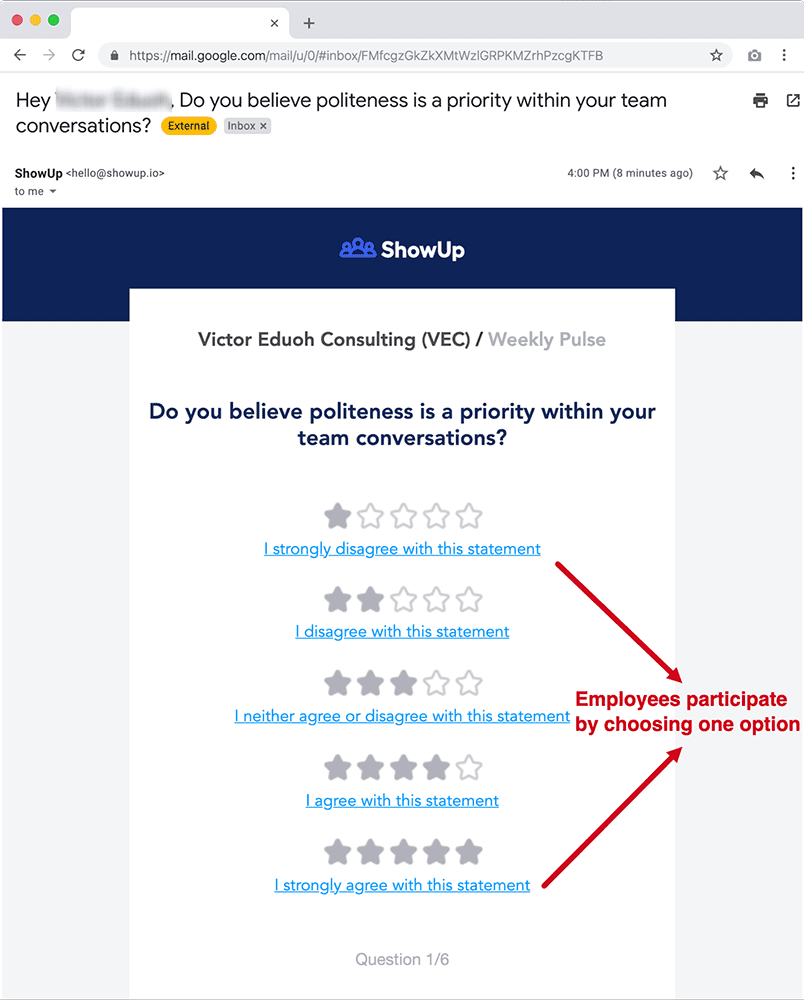
[ShowUp pulse survey helps managers track their team’s pulse]
Other ways to show support include:
Setting up mental health wellness programs, prioritizing team building activities and social interaction, and providing resources that can help them in the face of any mental health crises. All these help to build a better culture in your hybrid workplace.
Ensure inclusivity and equity between remote and physical workers
Penny Pullan, an expert in virtual and hybrid work leadership, said you need a level playing field in a hybrid environment.
Why did she say that?
She explained further:
When you’ve got some [employees] in the office and some remote, the inequalities can begin to creep in.
Oftentimes, it is an ‘out of sight, out of mind’ situation for remote workers. They feel neglected and alone compared to their in-office colleagues. This feeling takes a toll on them and affects the culture.
You, the manager, have the responsibility of ensuring the playing field is level in your hybrid company. Treat both remote and in-person workers as equal. Include them in conversations and activities.
Remember:
"For a healthy hybrid work culture, we need to help people overcome the FUD factor – the fear, uncertainty, and doubt – of being ‘left out’ of important conversations when they are not physically present", says Thomas Phelps, CIO at Laserfiche.
Give opportunities for growth
Another way to build your hybrid work culture is to give your whole team even more career opportunities. Invest in your team members, allow them to grow, and in return, your culture will flourish.
William Craig, founder, and president of WebFX offered advice on this:
When you strategically invest in employees, you attract and keep all the best candidates, and you also build a strong work culture unafraid of innovation, change, failure and success.
Better communication and connectivity
Communication has always been an integral part of good company culture, but with the complexities of a hybrid workplace, we find that good communication is even more essential.
Why?
Great communication connects hybrid employees and management together.
Hybrid companies need a communication system that works for both physical and virtual employees. No employee should be kept out of the loop.
To ensure this fluidity, a remote-first communication structure is preferable. This form of communication serves to include not exclude physical workers. Workplace communication and culture are interwoven, and they depend on each other.
Keep a finger on employees’ pulse
Employees’ needs, even in a hybrid workforce, are dynamic and always evolving. Therefore, to build and maintain a great culture, you need to keep a finger on their pulse to always meet their needs:
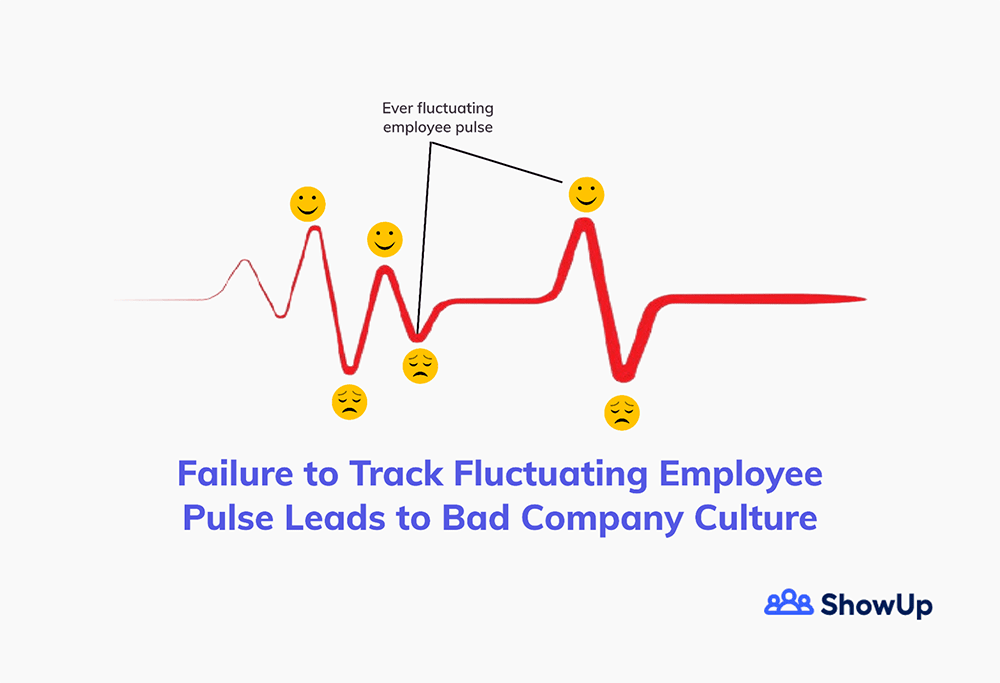
How do you keep a finger on their pulse?
By using tools specifically designed for that purpose. An example of such a tool is ShowUp. It is a manager’s trusty sidekick that serves to keep an eye on employees for the manager simply by giving them a voice:
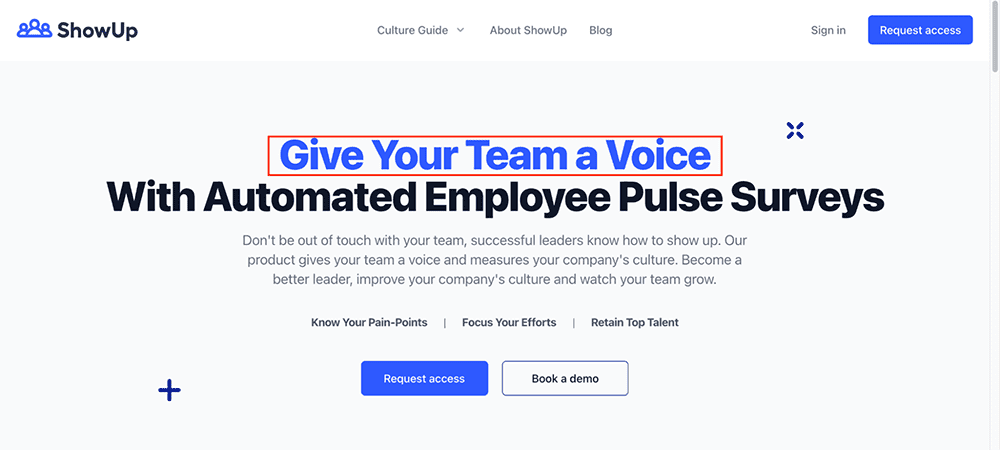
How?
ShowUp automatically sends out employee pulse surveys to your employees to gather feedback from them.
Why employee surveys?
Employee surveys have been found to be great for measuring team pulse. Like this Envoy’s piece corroborated,
Employee surveys are a great way to keep your finger on the pulse of how your hybrid workforce feels in real-time.
ShowUp’s automated surveys are sent out weekly or bi-weekly, depending on your preferences:
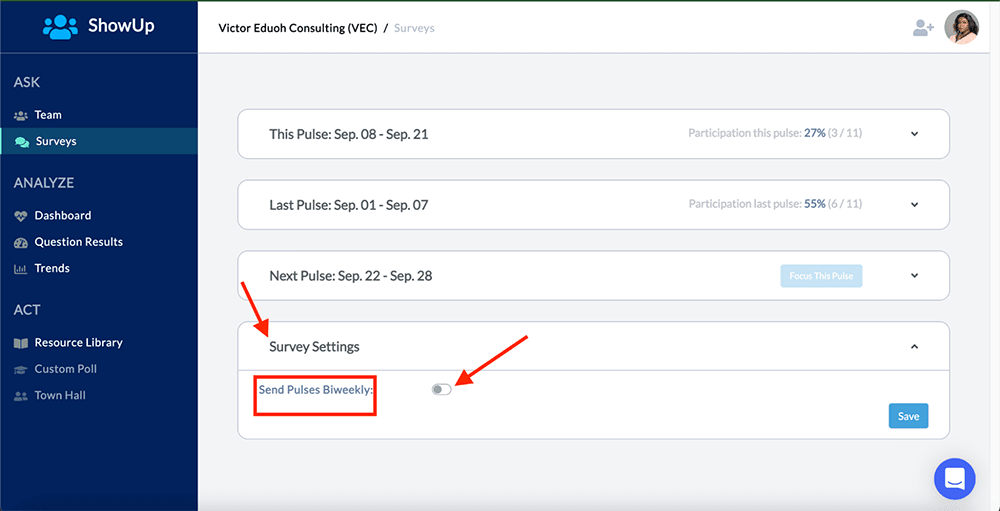
Right on your dashboard, you can see the areas you are excelling in, and the areas of your hybrid culture you need to work on:
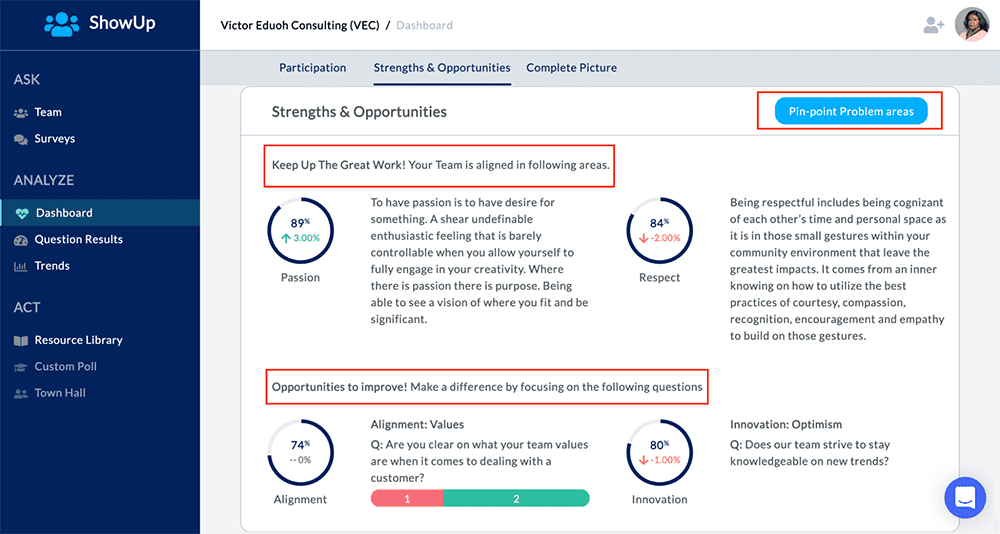
Then, with the feedback gotten over time, ShowUp crunches and distills the data for you into a line graph.
You get to see how the trend of culture in your hybrid workplace is going:

Oh, and the surveys are fully anonymous to maximize your chances of garnering genuine feedback:
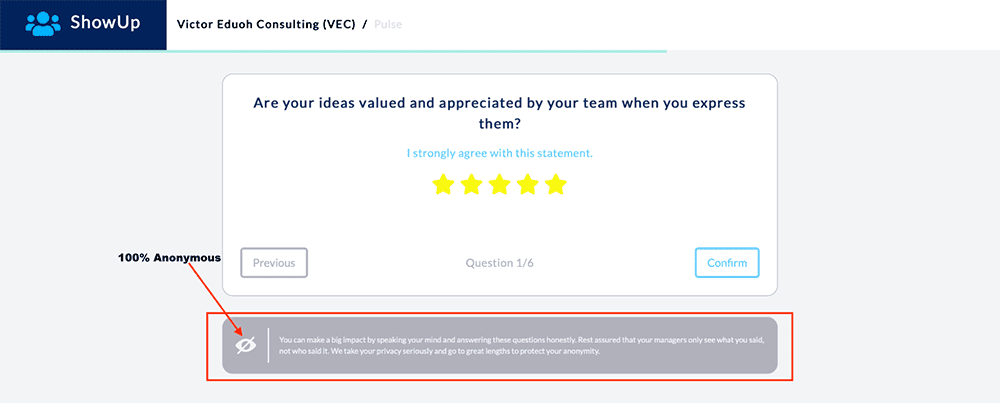
Keep a Finger on Employees Pulse With Automated & Anonymous Employee Pulse Surveys
Some Hybrid Work Culture Companies
A lot of companies have gone down the hybrid route in response to the challenges facing the workforce. Let’s see a few of such companies and their efforts towards culture.
Grammarly
The writing and communication tool rolled out a balanced working model called “remote-first hybrid” in the aftermath of the pandemic. Essentially, the team can work primarily from home, but also have the liberty to work in the company’s offices, or ‘hubs’ anytime they want.
On the culture, Brad Hoover, Grammarly’s CEO wrote:
“We strive to continue building an inclusive culture that fosters everyone’s growth. Our new remote-first hybrid model supports these principles.
Figma
At the beginning of the lockdown, Figma adopted a fully remote working model for all employees. But after a while, it became clear to the leaders that it wasn’t going to work post-COVID.
At a loss on what to do, the Co-founder and CEO, Dylan Field, partnered with the company’s head of people to create a survey to receive feedback from the employees themselves on what they really wanted.
What was the survey results feedback?
Dylan found employees loved the remote lifestyle, but still had an attachment to the physical office. So they created a hybrid model that appealed to the employees. They were to come into the office on two specified days of the week and work from home for the rest of the week.
He (Dylan Field) was also aware of how company culture is dynamic and always evolving. So he knew he had to change his company’s culture, and he wrote:
Looking ahead, we’re thinking a lot about how Figma’s culture needs to change so we can adapt to this hybrid world.
Mailchimp
Mailchimp adopted a pretty interesting work model or rather, work models. They introduced four flexible work models for employees to choose from:
- WFH: Employees primarily work from home or are fully remote with occasional office visits throughout the year.
- HomeFlex: Employees spend up to 2 days per week in the office with regular and planned work from home days.
- OfficeFlex: Employees spend 3 or more days per week in the office with regular and planned work from home days.
- Office: Employees work from the office of their choosing pretty much all the time, or are fully office-bound with occasional work from home days.
This is a cool initiative, because of the flexibility involved on the manager’s part. If you recall, management flexibility is a good thing, and one of the qualities that helps build a better culture in a hybrid environment.
Mailchimp was only able to arrive at these work models through the feedback they sought from employees.
Like Figma, Mailchimp also sent out surveys to its employees. Going by what we’ve seen from these two (now) hybrid companies, it is very important to seek feedback from employees. Doing this will aid you in building and maintaining a better culture.
And with the help of ShowUp, managers like you can receive feedback from your team using employee pulse surveys:
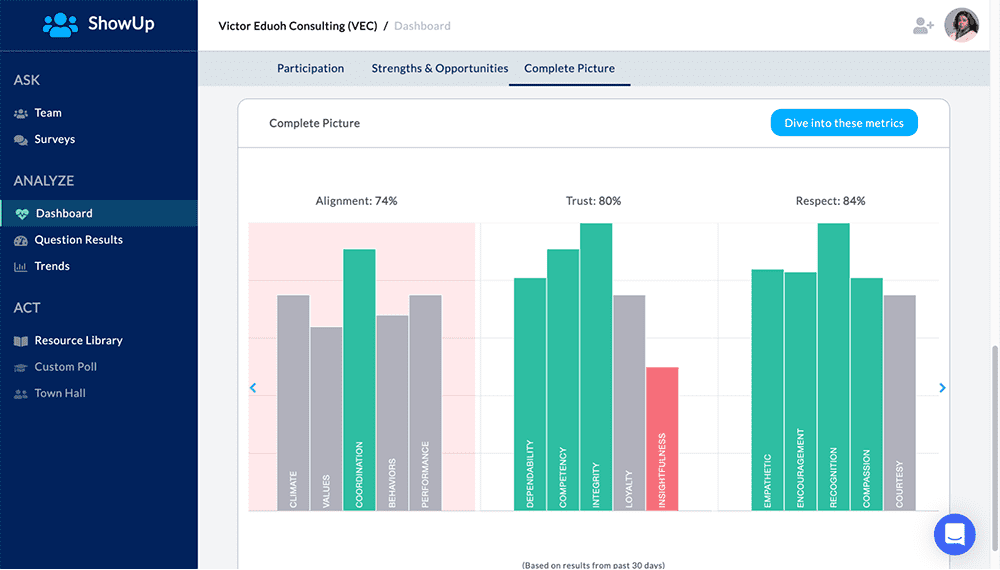
Takeaway: Workplace culture is a competitive advantage and brand differentiator for hybrid companies
As you build your hybrid company, it is necessary to build a better culture too. Because, your company’s culture is what will set your company apart from the competition, drive employee engagement, and retain top talent.
Brian Kropp, Chief of Research for the Gartner HR practice said:
It is critical that employers get their corporate culture and employee experience right during this period of uncertainty. Both facets help ensure organizations achieve the financial, reputation and talent outcomes that will drive business outcomes and competitive advantage.
In other words, having a great culture and customer service positively influences the success of your company. Therefore, as a manager, you should be committed to building the culture of your company, especially if it is a hybrid one.
But note…
It takes deliberate effort to build and sustain a hybrid culture. The 7 strategies I’ve outlined above will greatly help you.
Imprint these words of Tracy Brower Ph.D. Sociologist & Author in your mind:
The most important thing to realize about hybrid working is the intentionality and effort necessary to maintain culture. Nothing will be automatic, and it will be nearly impossible to have a positive culture by default. Culture has always been a challenge to strengthen and sustain, but with hybrid work models, the level of difficulty will be increased many-fold. It won’t be easy, but it will be worth it.
